Water and Wastewater Engineering
Подождите немного. Документ загружается.

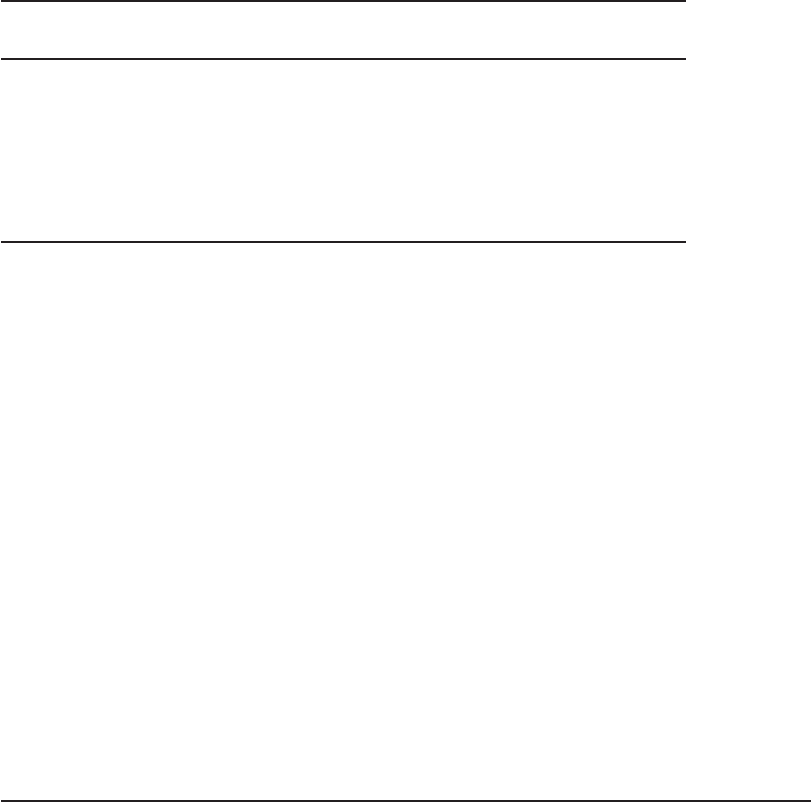
WATER PLANT RESIDUALS MANAGEMENT 15-37
Centrifuges are very sensitive to changes in the concentration or composition of the sludge,
as well as to the amount of polymer applied. Thus, the best way to evaluate centrifugation is by
using pilot tests. Cornwell (2006) provides a detailed proc edure for scaling up pilot results to
full scale. The best indi
cators of performance are the cake solids concentration and the centrate
suspended solids concentration.
For new plants without production sludge to test, similar facilities treating similar water are
the only option in evaluating this alternative for sludge dewatering.
Centrifuge Selection Considerations. Centrifuges can handle sludge solids
concentrations up
to about 4 percent. Centrifuges are often located on upper floors of the sludge building so that the
cake may be discharged into trucks or hoppers below. Because of the mass and vibration of the
centrifuge, special attention should be given to the structural requirements to handle the load and
vibration in evaluating the
cost of this option.
The best performance data for centrifuges have been obtained at 75 to 80 percent of the
manufacturer’s hydraulic or solids capacity. A typical selection of centrifuges is shown in
Table 15-8 .
Example 15-7. Select a centrifuge to dewater a coagulation sludge that has been thickened to
2.
5%. The initial sludge flow rate is estimated to be 128.4 m
3
/ d, and the design sludge flow rate
is 171.2 m
3
/ d. The plant managers wish to operate on a two-shift basis, that is, 16 h/d to minimize
labor costs. Using Table 15-8 , select an appropriate centrifuge system.
Solution:
a . Calculate the hourly sludge flow rate for a 16-hour operation at the initial and des ign
sludge flow rates.
TABLE 15-8
Typical selection of centrifuges
Model
Flow rate,
a
m
3
/h
Bowl
diameter, cm Length, m Width, m Height, m Weight, kg
25 4.5 25 2.1 1.1 0.8 1,300
309 30 2.4 1.1 0.9 1,500
35 18 35 2.8 1.4 1.0 2,500
4530453.2 1.5 1.0 3,500
55 60 55 3.7 1.6 1.1 4,500
65 70 65 4.4 2.0 1.2 7,500
75 110 755.9 2.7 1.3 13,000
a
Maximum solids concentration 4%
Note: These centrifuges are representative but do not represent actual choices. Actual manufacturers’ data
must be used for real world design.

15-38 WATER AND WASTEWATER ENGINEERING
Q
sludge initial
m /d
h/d
or
128 4
16
8025 8
3
.
.
m /h
m /d
h/d
sludge design
3
3
171 2
16
10 7Q
.
.oor m /h11
3
b. From Table 15-8 , the Model 30 centrifuge rated at 9 m
3
/h appears to be satisfactory for
the initial sludge flow rate, but not the the design flow rate. Using the 75 to 80% rule of
thumb as a safety factor,
()( )075 9675
33
..m /h m /h
would provide the best performance for this centrifuge. This is not satisfactory.
c. An alternate design that would also provide redundancy would be to provide two centri-
fuges rated at 9 m
3
/h. This scheme would allow for an operational time of
128 4
2675
9 511
3
3
.
.
.
m /d
centrifugesm/h()()
oor h/d9 5.
The capacity of the two centrifuges at the design sludge flow rate would allow for operation
171 2
2675
12 68
3
3
.
.
.
m /d
centrifugesm/h()()
oor h/d13
d. Another scheme would be to provide one centrifuge rated at 18 m
3
/h. While this scheme
would provide the same operating hours as the two centrifuge option, it would not provide
any redundancy.
Comments:
1 . Among the many other alternatives to be considered are redesign of the thickener to
yield a higher solids loading at a lower flow rate, or other manufacturers’ products with
a different sele
ction of sizes.
2. For the two centrifuge option, the initial operating schedule should alternate the centri-
fuges’ use to both extend their life and make use of the manufacturer’s warranty.
3. As may be noted, at the design life, there is no redundant centrifuge. Either sludge stor-
age or the provision of space for the addition of another
centrifuge when the capacity
of the two centrifuges does not allow for redundant operation are options that might be
considered.
Vacuum Filtration. A vacuum filter consists of a cylindrical drum covered with a filtering
material or fabric, which rotates partially submerged in a vat of conditioned sludge. A vacuum is
applied
inside the drum to extract water, leaving the solids, or filter cake, on the filter medium. In
practice, a differential pressure of about 70 kPa is applied. As the drum completes its rotational
cycles, a blade scrapes the filter cake from the filter and the cycle begins again. Two basic types
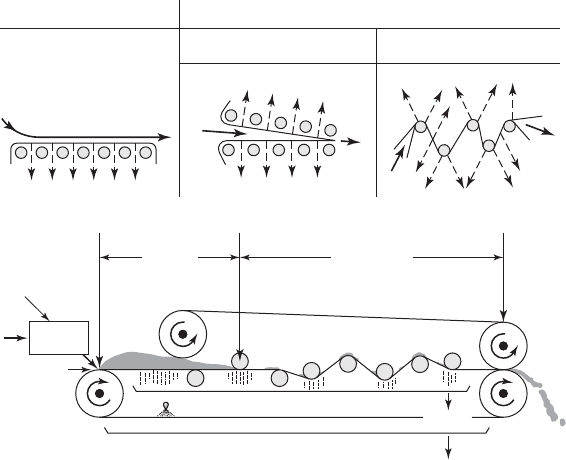
WATER PLANT RESIDUALS MANAGEMENT 15-39
of rotary drum vacuum filters are used in water treatment: the traveling medium and the precoat
medium filters. The traveling medium filter is made of fabric or stainless steel coils. This filter is
continuously removed from the drum, allowing it to be washed from both sides without dilu
ting
the sludge in the sludge vat. The precoat medium filter is coated with 50 to 75 mm of inert mate-
rial, which is shaved off in 0.1 mm increments as the drum moves.
Vacuum filters are not recommended for coagulation sludges.
Continuous Belt Filter Press (CBFP). The belt filter press operates on the principle that ben
d-
ing a sludge cake contained between two filter belts around a roll introduces shear and compres-
sive forces in the cake, allowing water to work its way to the surface and out of the cake, thereby
reducing the cake moisture content. The device employs double moving belts to continuous ly
d
ewater sludges through one or more stages of dewatering ( Figure 15-9 ). Typically the CBFP
includes the following stages of treatment:
1 . A reactor/conditioner to remove free-draining water.
2. A low pressure zone of belts with the top belt being s olid and the bottom belt being a
sieve; here further water removal occurs, and a sludge mat having significant dim
en-
sional stability is formed.
3. A high pressure zone of belts with a serpentine or sinusoidal configuration to add shear
to the pressure dewatering mechanisms.
Gravity drainageCompression dewatering
Low-pressure section
Gravity
drainage
stage
Compression
dewatering
stage
Chemical
conditional
stage
Polyelectrolyte
solution
Sludge
Conditioned
sludge
Wash spray
Washwater
Filtrate
Sludge
cake
High-pressure section
Mixer
FIGURE 15-9
Continuous belt filter press.
( Source: U.S. EPA, 1979.)
15-40 WATER AND WASTEWATER ENGINEERING
The design and selection of a belt filter press is often based on the “throughput” of the
press. Throughput i s the rate at which residuals can be dewatered. The throughput can be either
hydraulically or solids limited. A belt press having a particular type and width of belt has a max-
imum loading capacity for a given type of res
idual. The solids loading is considered the m ost
critical factor, and throughput is expressed in terms of solids loading: kg/meter of belt width per
hour. For coagulant sludges the typical loading rate is about 150 kg/m · h, but sludges thickened
to 4 perc
ent may be loaded at a rate of 400 to 570 kg/m · h (Cornwell, 2006). Lime sludges up to
30 percent solids have been dewatered to 60 percent solids (MWH, 2005). Typical belt widths
are 1.0, 1.5, 2.0, and 3.0 m.
Discharge from the press may be directly to a truck. Other options include conveyors and
hoppers or roll-off boxe
s.
The belt press has a relatively low energy requirement compared to other mechanical de-
watering devices . To achieve acceptable solids conc entrations, the sludge fed to the CBFP
must be conditioned. Polymers are often used for conditioning. In addition, belt wash water
must be provided. This wash water represent
s another disposal issue as it will be high in sus-
pended solids.
Plate and Frame Filter Press. The basic component of a filter press is a series of recessed
vertical plates. Each plate is covered with cloth to support and contain the slu dge cake. The
plates are mounted in a frame consisting of two head support
s connected by two horizontal paral-
lel bars. Conditioned sludge is pumped into the pressure filter and passes through feed holes in
the filter plates along the length of the filter and into the recessed chambers. As the sludge cake
forms and builds up in the chamber, the pressure gradually increases to a point where further
slud ge injection would be counterproductive. At this time the injection ceases. A variation of
the standard plate and frame filter press is the diaphragm filter press. The construction is similar
to the standard recessed chamber, but the drainage surfaces on the face of the plates are flexible
membrane
s or diaphragms. After the filtration cycle is completed and the recessed chambers
are filled with solids, and before the press is opened, air or water pressure is applied behind the
diaphragms causing them to flex outward to exert additional pressure on the filter cake. This
squeezes the cake and further reduces any re
maining moisture.
The diaphragm filter press yields a higher cake solids and has a shorter cycle time than the
standard plate and frame press. Although the filter press may be highly automated, the operation
will require significant operator attention. Current models are provided with “cake breakers” to
dislodge the cake from the press. These m
ay need operator attention to ensure that the cake is com-
pletely dislodged. The operation and schematic cross sections are illustrated in Figure 15-10.
A typical pressure filtration cycle begins with the closing of the press to the position shown on
Figure 15-10a. Sludge is fed for a 20- to 30-minute period
until the press is effectively full of cake.
The pressure at this point is generally the designed maximum (700 to 1,700 kPa) and is maintained
for one to four hours, during which more filtrate is removed and the desired cake solids content
is achieved. The filter is then mechanically opened
, and the dewatered cake is dropped from the
chambers onto a conveyor belt or hopper for removal. Cake breakers are usually required to break
up the rigid cake into conveyable form. Because plate pressure filters operate at high pressures and
because many units use lime for conditioning, the cloths require routine wa
shing with high-pressure
water, as well as periodic washing with acid.
While filter presses work well for lime sludges, they require large quantities of conditioning
agents, including lime and fly ash, to produce a dry cake from coagulation sludges. In either case,
thickening before filtration is typical.
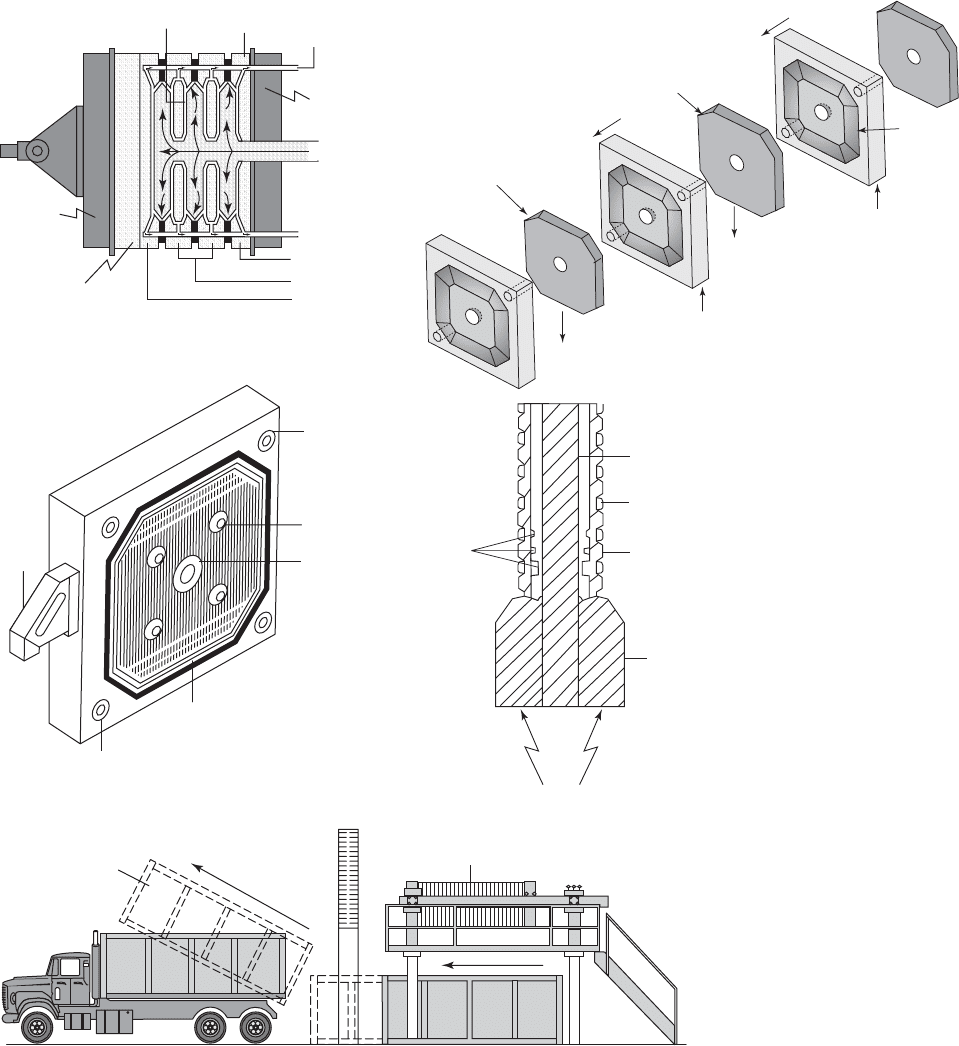
WATER PLANT RESIDUALS MANAGEMENT 15-41
FIGURE 15-10
Plate and frame filter press. ( a ) Filling the press, ( b ) cake breaking, ( c ) plate details for recessed plate, ( d ) diaphragm plate details,
( e ) plate and frame solids off-loading system.
Polypropylene
plates
Filter cloth
Clear
filtrate
Head
Inlet feed
of slurry
(a)
Head plate
Tail plate
Back-up
plate
Follower
Intermediate plates
Filter cake
F
ilter
c
ake
Filter cloth
Plate separates
Plate separates
Filter plate
Filter plate
Cake falls
(b)
Cake falls
Plate
support
handle
Feed eye
Wash water or
air blowdown por
t
Stay boss
Discharge eye
(c)
Gasket
Chambers
(e)
Roll-off box
Center Web
Piped drainage
surface
Flexible
diaphragm
Cloth sealing
area
Diaphragm
supports
Two halves of
molded diaphragm
plate laminated to
center web
(d)

15-42 WATER AND WASTEWATER ENGINEERING
Alum sludges are conditioned using lime and/or fly ash. Lime dosage is typically in the range
of 10 to 15 percent of the sludge solids. Fly ash is applied at dosage of about 100 percent of the
sludge solids. Polymers are dosed in the range of 1 to 2 g/kg. While cake solids may be between
45 and 50 percent dry solids, as much as 30 percent of the dry solids may be conditioning chemi-
cals and/or fly ash. To reduce the volume of sludge, only polymer may be used for conditioning.
This is an economic i
ssue as well as an operational issue. The cost of polymer, which is very
expensive, must be weighed against the cost of disposing of a larger volume of solids.
E xample 15-8 illustrates the method for selecting an appropriate size filter press from manu-
facturer’s data like that shown in Table 15-9 .
TABLE 15-9
Typical filter press manufacturer’s data
Press size Volume, L No. of chambers Length, m
H 3.5 m
W 2.7 m
3,500 64 7.7
4,300 77 8.7
5,000 90 9.5
5,700 103 10.4
6,400 115 11.2
7,100 128 12.1
7,800 141 13.0
H 4.2 m
W 2.7 m
5,700 74 8.4
6,500 84 9.1
7,000 91 9.6
7,700 100 10.2
8,500 110 10.9
9,300 120 11.6
10,000 130 12.2
H 3.9 m
W 3.9 m
8,500 89 9.5
9,600 100 10.2
10,600 110 10.9
11,500 120 11.6
12,500 130 12.2
13,400 140 12.9
14,400 150133.6
Note: These presses are representative but do not represent actual choices.
Actual manufacturer’s data must be used for real world design.

WATER PLANT RESIDUALS MANAGEMENT 15-43
Example 15-8. A lime softening water treatment plant with a design capacity of 30,000 m
3
/ d
is being designed. A filter press has been selected as the method of dewatering the sludge for
landfilling. The calculated removals of hardness and the design characteristics of the sludge are
given below. Based on experience, a cycle time of four hours is anticipated. This incl
udes filling,
pressing, and discharging the sludge. From Table 15-9 select an appropriate press.
CaCH 198 mg/L as CaCO
3
MgCH 15 mg/L as CaCO
3
CaNCH 0.0 mg/L as CaCO
3
MgNCH 55 mg/L as CaCO
3
CO
2
18 mg/L as CaCO
3
Specific gravity of sludge 1.1
Specific gravity of dewatered sludge 1.176
Percent solids delivered to the filter press 10%
Dewatered solids 25%
Solution:
a . Begin by estim ating the daily dry solids sludge production using Equation 15-17. The
flow rate in appropriate units is
Q
30 000
86 400
0 3472
3
3
,
,
.
m /d
s/d
m /s
Using Equation 15-17, the estimated mass of dry solids is
M
s
86 4 0 3472 2 198 2 6 15
3
.. .()[()(m /smg/L mg/LL
mg/L mg/L kg/d
)
() ] 00 1655 18 16 229.. ,
b. Estimate the volume of sludge using Equation 15-9.
sl
16 229
1000 11 010
147
3
,
,..
kg/d
kg/m()()()
.. ,5 147 500
3
m /d or L/d
V
c. The volume of the filter press in liters is estimated using Equation 15-11.
dewatered
L/d g/L
()()()(147 500 0 10 1 000 1,.,..
., .
,,
1
1 176 1 000 0 25
55 187 55 2
)
()( )()g/L
or 000 L/d
V
d. At four hours per cycle, the volume of the press must be
()()55 200 4
24
9 200
,
,
L/d h/cycle
h/d
L/cycle
e. From Table 15-9 two models will work:
H 4.2 m and W 2.7 m with 120 plates has a capacity of 9,300 L
H 3.9 m and W 3.9 m with 100 plates has a capacity of 9,600 L

15-44 WATER AND WASTEWATER ENGINEERING
Comments:
1 . Of the two possible choices, the larger press ( H 3.9 m and W 3.9 m) has the advan-
tage of using fewer plates. Fewer plates means a smaller number of things that can go
wrong. The shorter length will also result in a better distribution of solids. Because the
frame for the larger plates can be expanded to 150 plates, this press
also offers the pos-
sibility of expansion by adding plates.
2. Not addressed here is redundancy and staff management, which are issues that also must
be considered.
15-8 MANAGEMENT OF LIQUID RESIDUALS
Conventional methods of disposal of liquid residuals from ion exchange and membrane pro-
cesses include discharge to surface water bodies, dilution and spray irrigation, deep well injec-
tion, drain fields, and discharge to municipal sewers. Table 15-10 summarizes
the regulatory and
other environmental requirements with these disposal methods. Decision trees for selection of a
management alternative for MF/UF and NF/RO residuals are shown in Figures 15-11 and 15-12
on pages 15-45 and 15-46.
TABLE 15-10
Concerns and requirements associated with conventional disposal methods
Disposal method Regulatory concerns Other requirements
Disposal to surface water Receiving stream limitations Mixing zone
Radionuclides Possible pretreatment
Odors (hydrogen sulfide) Multiple-port diffusers
Low dissolved oxygen levels Modeling of receiving stream
Su
lfide toxicity
Low pH
Deep well injection Confining layer Well liner
Upconing to drinking water wells Monitoring well
Injection well integrity Periodic integrity test
Corrosivity Water quality of concentrate must
be compatible with the water
quality in the injection zone
Spray irrigation Groundwater protection Monitoring wells
Possible pretreatment
Backup disposal method
Need for irrigation water
Availability of blend waters
Drainfield or borehole Groundwater protection Monitoring wells
Proper soil conditions and/or rock
permeability
Sanitary sewer collection
systems
Effect on local wastewater
treatment plant performance
(toxicity to biomass or inhibited
settleability in clarifiers)
None
Source: AWWA, 1996.
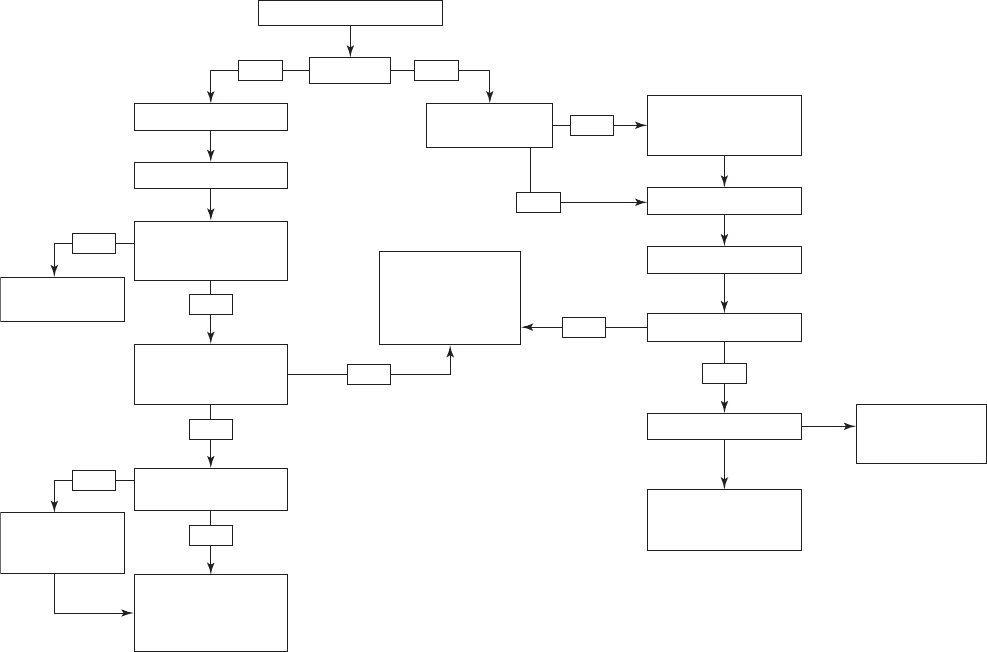
WATER PLANT RESIDUALS MANAGEMENT 15-45
15-9 DISPOSAL OF SPECIFIC RESIDUAL CONSTITUENTS
Arsenic Residuals
Unless the arsenic concentration is less than 5.0 mg/L, regenerant from ion exchange, activated alu-
mina and modified iron removal (MIR) plants, as well as reject from reverse osmosis will exceed
the toxicity characteristic and must be disposed of as a hazardous waste at an approve
d hazardous
waste treatment facility. Iron-based sorbents and sludges from iron and aluminum coagulation as
well as enhanced lime softening must be tested using the toxicity characteristic leaching procedure
(TCLP) or, in the case of California, the waste extra
ction test (WET) to determine if they are clas-
sified as a hazardous waste. Testing of sludges has resulted in the conclusion that sludges do not
qualify as a hazardous waste because the TCLP levels are under 5.0 mg/L (Cornwell et al., 2003).
However, these sludges m
ay not pass the WET, so individual evaluation is warranted.
The potential regulatory requ irements are shown in Figure 15-13. A decision tree for han-
dling and disposal of arsenic residuals is shown in Figure 15-14 on page 15-47.
Spent CIP?
Adjust pH to 6.0 to 9.0
Are coagulation
chemicals present?
Neutralize oxidants
Nautralize oxidants
Are levels of TSS,
organic compounds,
and TDS acceptable?
– Sewer discharge with
pretreatment permit
– Haul offsite for
appropriate disposal
– Recycle
– Surface discharge
(as permitted)
– Spray
irrigation
– Sewer discharge
Surface discharge
(as permitted)
Liquid–solid separation
– Recycle
– Surface discharge
– Sewer discharge
– Dewater for land
disposal
– Land application
Contaminant removal
required?
Solids removal required?
Treat as spent filter
backwash from
conventional WTP
A
djust pH to 6.0 to 9.0
Spend backwash and CEBW
No
Yes
Yes
Yes No
Yes
Treatment for
contaminant
removal
Yes
No
Would blending with
spent backwash make
it acceptable?
No
Solids
Treated
water
Yes
No
No
FIGURE 15-11
Decision tree for MF/UF residuals. (CIP—c lean in place chemicals, CEBW—chemically enhanced backwash, TSS—total suspended solids, TDS—total
dissolved solids.)
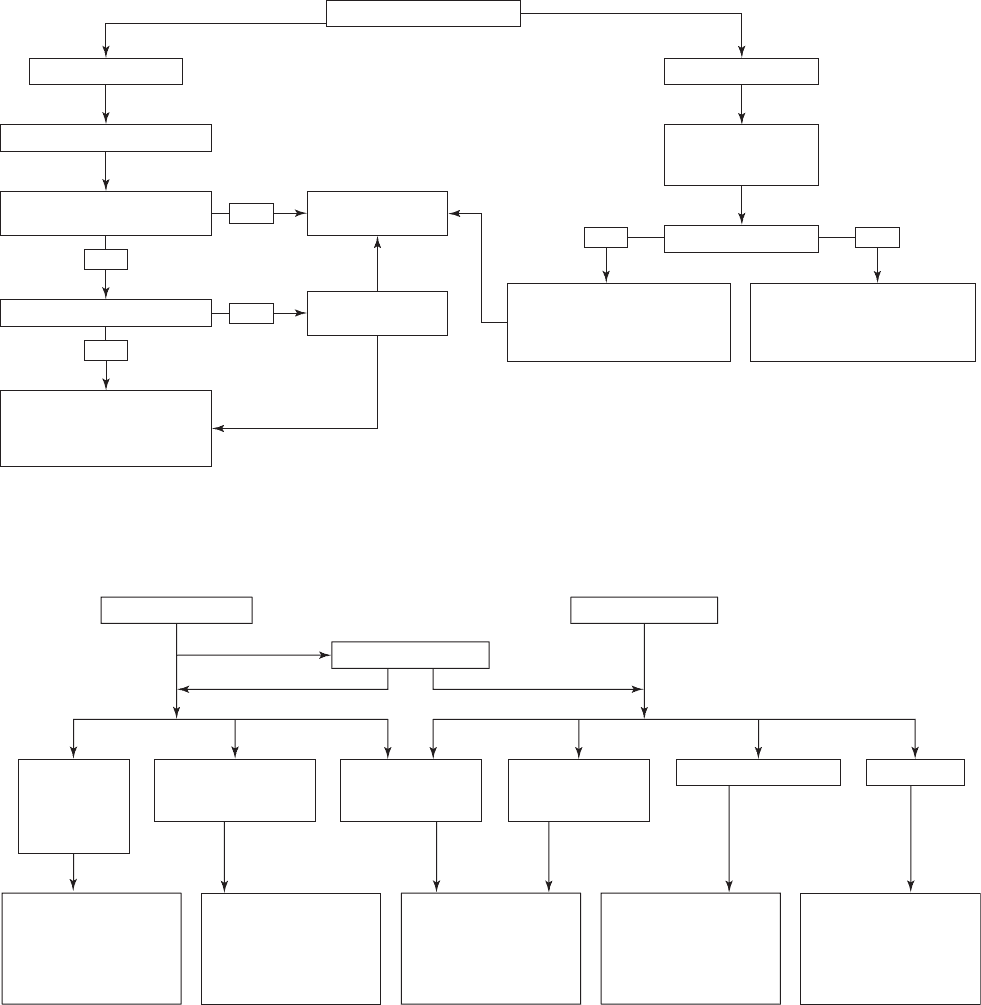
15-46 WATER AND WASTEWATER ENGINEERING
NF/RO Membrance Residuals
Adjust pH to 6.0 to 9.0
Spent CIP Concentrate
Adjust pH to 6.0 to 9.0
Neutralize oxidants/Cl
2
as needed
Are levels of TSS, organic
compounds, and TDS acceptable?
Contaminant removal requred?
– Sewer discharge with
pretreatment permit
– Haul offsite for appropriate
disposal
Solids and
concentrates
Treatment for
contaminant removal
Treated
water
Surface discharge
(as permitted)
Surface disc
harge?
– Increase dissolved oxygen level
(as required)
– Remove H
2
S (as required)
– Sewer discharge
– Deep well injection (as permitted)
– Evaporation pond
– Zero liquid discharge
Neutralize chlorine
(ED/EDR only) as
needed
No
Yes
Yes
No
Yes
No
FIGURE 15-12
Decision tree for NF/RO membrane residuals management. (CIP—clean in place chemicals, TSS—total suspended solids, TDS—total dissolved solids.)
Underground injection
Deep well
Hazardous landfill
Land disposal
Sanitary industrial
Reuse
Land application
Wetland/ocean disposal
Incineration
Discharge
Direct/indirect
surface water,
wetland, ocean,
sanitary sewer
Solid/sludge residuals
Liquid residuals
Interim treatment
Clean Water Act
NPDES program
40 CFR Parts 122–133
Pretreatment program
40 CFR Part 403
Resource Conservation
and Recovery Act
Subtitles C and D programs
40 CFR
Parts 257–270
Clean Water Act
Dredge and fill
programs
40 CFR
Parts 230–233
C
lean Water Act/
Resource Conservation
and Recovery Act
40 CFR
Parts 26, 50, 60–63
Safe Drinking Water Act
Underground injection
control program
40 CFR
Parts 141–149
FIGURE 15-13
A r senic residuals disposal—federal regulations. (Adapted from U.S. EPA, 2000.)
